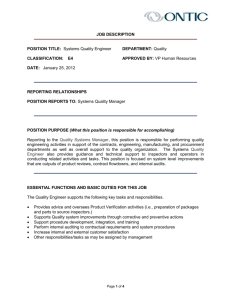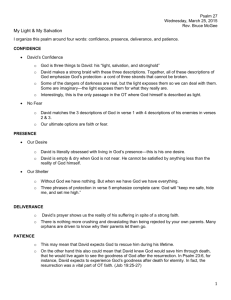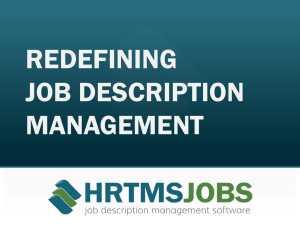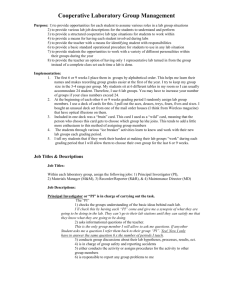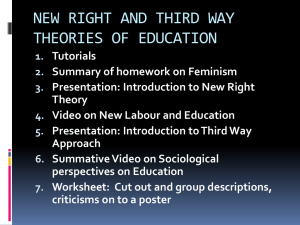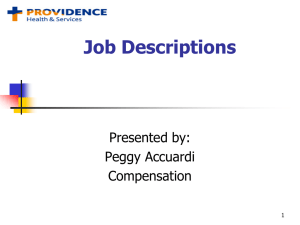JOB ANALYSIS AND JOB DESCRIPTION
advertisement
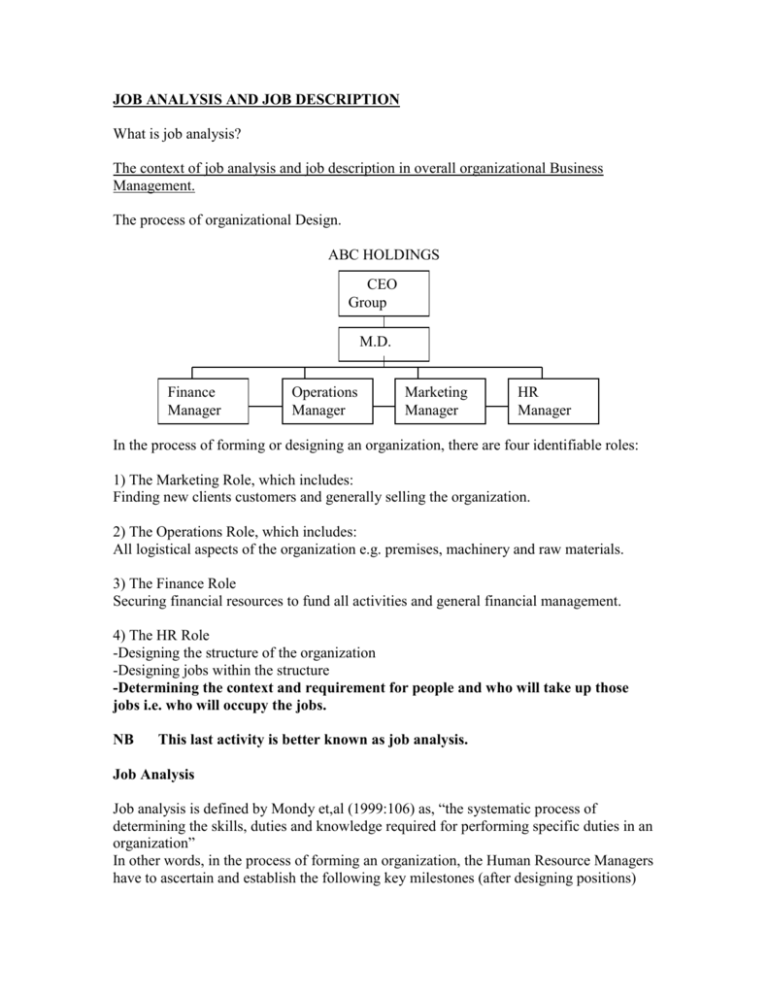
JOB ANALYSIS AND JOB DESCRIPTION What is job analysis? The context of job analysis and job description in overall organizational Business Management. The process of organizational Design. ABC HOLDINGS CEO Group M.D. Finance Manager Operations Manager Marketing Manager HR Manager In the process of forming or designing an organization, there are four identifiable roles: 1) The Marketing Role, which includes: Finding new clients customers and generally selling the organization. 2) The Operations Role, which includes: All logistical aspects of the organization e.g. premises, machinery and raw materials. 3) The Finance Role Securing financial resources to fund all activities and general financial management. 4) The HR Role -Designing the structure of the organization -Designing jobs within the structure -Determining the context and requirement for people and who will take up those jobs i.e. who will occupy the jobs. NB This last activity is better known as job analysis. Job Analysis Job analysis is defined by Mondy et,al (1999:106) as, “the systematic process of determining the skills, duties and knowledge required for performing specific duties in an organization” In other words, in the process of forming an organization, the Human Resource Managers have to ascertain and establish the following key milestones (after designing positions) 1. What skills are required for one to perform well in that position? (SKAs) 2. What actual duties will that person perform? 3. How do those duties fit in within the context of the whole organization? (Why are they there)? While in this case job analysis was conducted when the organization was being founded. As a process (not an event or activity), job analysis continues throughout the life of an organization and will be again be carried out when 1. New jobs are created. 2. Change management in the organization processes is taking place. Job Descriptions/ Position Content Summary When the job analyst has discovered through the process of job analysis, the content of a job. S/HE then sets out this information in a descriptive document called a job description, which is also known as a ‘Position Content Summary’. Thus a job description is defined by Armstrong M (2001:326) as follows, “a job description sets out the purpose of a job, where it fits in the organization structure, the context within which the job holder functions and the principal accountabilities of job holders, or the main tasks they have to carry out”. Job Specification /Person specification Mondy et al (1999:107) defines a job specification as a, “document that outlines the minimum acceptable qualifications a person should posses to perform a particular job”. In other words job analysis would have identified what the jobholder should posses in order for him to successfully carry out the tasks and responsibilities in a job. E.g. what is the person specification for an HR Manager? This information is set out in the document called a job /person specification. While the job specification can be regarded, as a document on its own, in practice this is not the case as it is usually contained within the job description itself. That is it appears as a section of the job description document therefore it should be noted that in practice, only one document is produced after job analysis. Thus a job description. Job Analysis & Job Description : Critically analyze the possibility of having one without the other? Type of data collected in Job Analysis The analysis produces the following information about a job (Armstrong: 327) 1. Overall purpose-why does the job exist in the organization 2. Content Tasks (e.g. feed sales data in a computer that is the job for Sales Administrator a) Operations b) Duties c) Skill 3. Accountabilities: The results of the job e.g. for an HR Manager “the efficient and effective utilization of the organization’s human resources to enhance shareholder value” 4. Performance criteria-work standards e.g. time taken -Error analysis (margins of error) -Other work measurements 5. Responsibilities-the job holder’s responsibilities in terms of the scope of the job and amount of discretion allowed on the job, the complexity of the job and problems inherent in it. 6. Resources Controlled-what resources are used or needed to accomplish the job (organizational factors) 7. Relationships-reporting relationships and other liaisons. 8. Development factors-promotion and career prospects 9. Environmental factors- (working conditions, healthy and safety considerations, working hours (if unusual), working hazards and precautionary measures. 10. Qualifications (Minimum) –This information or data collected through job analysis can be qualitative, narrative or quantitative or both in most cases. Job Analysis Methods There are various methods used by job analysts. The job analyst will select a method which is most appropriate depending on what the information to be collected will be used for e.g. job evaluation, training etc .The following are the most commonly used methods: 1. Questionnaire: Here the job analyst administers a structured questionnaire, which the jobholder fills, or answers verbally. Information gathered through a questionnaire should always be verified with a supervisor to ensure that the jobholder does not exaggerate his duties or responsibilities. (Advantages & disadvantages) 2. Observation: The job analyst can personally gather data by watching/observing the jobholder perform his tasks and record these observations. This method is most appropriate for manual jobs e.g. a machine operator but is insufficient for jobs that require mental skills e.g. financial analyst (advantages & disadvantages) 3. Interviews: The jobholder is interviewed and assisted to describe his job. A cross analysis of the findings is also done with the supervisor who will verify the information given by the job holder (advantages &disadvantages) 4. Employee recording/Diary/log method Employee records his daily activities in a diary or log, which the job analyst then examines to gather information about the job. They are best suitable for managerial and other complex jobs. (Advantages & disadvantages) 5. Combination of methods: Because of the disadvantages found in each method it is advised that job analysts should use a combination of methods. E.g. the questionnaire method can be followed by an interview or the interview method itself supplemented by observation to verify findings and come up with accurate job descriptions. (Advantages & Disadvantages) 6. Others: (a) (b) (c) Critical incident techniques Reporting grid analysis FJA (functional job analysis) The student is expected to research on the advantages and disadvantages of these Job Analysis methods The procedure of conducting job analysis. Large organizations have full time job analysts. However the majority of organizations in Zimbabwe makes use of industry (NEC) Job analyst or alternatively hire consultancy. Better still others, particularly the medium sized ones, make use of supervisors and HR personnel to carry out job analysis. In any case, this is the procedure one should follow in carrying out job analysis. 1. Learn as much as possible about the organization, department and the job. An organization chart and a previous job description are the starting point. 2. Talk to the individuals involved and the supervisors about the job analysis, what it is and what it seeks to achieve. Alternatively the supervisor can do this. 3. Make an appointment with individuals concerned 4. At the start of the analysis develop good rapport with the individuals concerned 5. After gathering the information, draw up a draft job description/specification 6. Verify the information on the draft with the supervisor and the HOD (Make sure that both of them sign) 7. File the endorsed Job Description Document in the appropriate place. The significance of Job Analysis and Job Description in Human Resource Management. Job Analysis & Job Descriptions are fundamental activities in human resource management in general. In other words, no human resource activity can be meaningfully done without a Job Description emanating from a Job Analysis. The following is how and why: Explain how Job Analysis & Job Descriptions affect the following practices -Human Resource Planning -Recruitment and selection -Performance management -Reward Management -Safety and Health -Employee Relations -Diversity management JA & JDs Job descriptions. Having established that job analysis is a continuous process, it follows therefore that, job descriptions are or should be continuously updated in line with changes in the nature and content of a job. The format and content of a job description. The following is an overview of the key contents of a job description and its format. 1) Job identification -Job title -Department -Reporting relationship -Job code number Note: A Job title must appropriately identify and give a true character of the job. 2) Date of job analysis This is key in terms of ensuring that an organization does not run an obsolete Job Descriptions 3) Job Summary A short paragraph about the overall purpose of a job (see news paper advert) 4) Duties. Listed usually in the chronological order 5) The rest as per Job Analysis data. 6) Job Specification The last part of the JDs identifying skills and activities required to perform the job. It also incorporates experience, physical ability and personal traits. This information is key to Recruitment & Selection. Tailoring JDs for specific purposes. Job descriptions can be tailor made for a specific purpose. That depending on what the organization wants to use the job description for, the format and content can be tailor made to suit that particular purpose e.g. -For healthy and safety Audit-a job description that emphasizes a lot on working conditions and resources to be used. -For job evaluation-If for example the organization uses the Paterson Job Evaluation system it can include a special section that addresses the nature and importance of decision-making in that job as the system is based at that. -For Recruitment & Selection- This kind of a job description may include an expanded person specification Legal implications for Job Analysis & Job Descriptions A job description is an organization’s formal and legal document in as far as the definitions and understanding of jobs is concerned. The organization can therefore use job descriptions in legal cases such as 1) Recruitment and selection disputes 2) Dismissal disputes (for incompetence) 3) Discrimination disputes (for racism and tribalism claim) The future of Job Analysis and Job descriptions. There is a school of thought, which suggests that perhaps Job Descriptions are soon going to be a thing of the past in view of new business management concepts such as 1) Flexibility (the flexible firm)-Job Descriptions promote rigidity on the other hand. 2) Job enlargement- (Job Descriptions cannot capture the enlarged jobs) 3) Job enrichment-Job Descriptions cannot capture all the aspects of an enriched job. 4) Business Process Reengineering (BPR), the constant and sometimes radical change of an organization’ s structure and business processes to suit critical needs at a given time means that Job Descriptions become obsolete. Job Analysis & Job Descriptions Policy Organization must have a clear policy on: 1) The importance it attaches to Job Analysis & Job Descriptions. It must show that Job Analysis & Job Descriptions are a prerequisite for all Human Resource Management activities 2) When should Job Analysis & Job Descriptions be carried out e.g. yearly or when there is a major reorganization change to avoid obsolete Job Descriptions? 3) How the Job Analysis should be done and the methods and procedures to be used Note that Job Analysis & Job Descriptions are the starting point in all Human Resource Management activities Question: What is the future of Job Descriptions, Are they relevant? Will they be relevant in these changing times?. 2) Can a Job Description capture all aspects of a job? How about the emotional aspects like anger, excitement etc? Skills Practice - Read newspapers and job adverts Construct a job description after conducting a small job analysis

